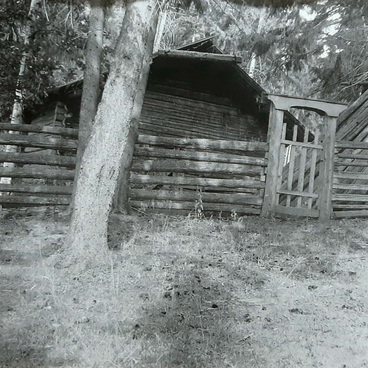Hammer tongs are lever pliers with long handles linked by a joint. They weigh 16 kilos. Only a strong person could work with the tool. The hammer tongs were used to take blanks from a hearth to an anvil, as well as to hold the blanks while processing. These hammer tongs were mainly used for metal working.
The exposed hammer tongs were used at the Izhevsk Steel Works. At first, wooden tongs were used for production of wrought iron. However, wooden tools were constantly burning, so they were gradually replaced with metal tongs. Hammer tongs were a must have tool for working with a hearth, or an anvil. They differed in size, construction, and jaws shape.
Hearth furnaces were installed at a hammer shop. At first, artisans laid charcoal and pieces of cast iron to the hearth. The cast iron was brought from a warehouse on carts. Then, a fire was blown in the hearth; water was let down on water wheels. Later, bellows started blowing air through tuyeres, special devices for blowing in air.
The dry charcoal quickly heated up, the temperature rose higher and higher; the cast iron began to melt, and liquid metal flowed to the bottom of the hearth. A furnace operator carefully controlled the melting process. On his signal, workers mixed the melted cast iron with iron bars.
An iron ball formed at the bottom of the hearth. It could weigh 10—20poods, or 160–320kg. This direct-process malleable iron was simply called ‘a ball’. It was turned out with a special big iron hook and melted again to remove impurities from the metal. The ball was ‘ready’ in 8–12 hours. An artisan and his apprentice took the ball out of the hearth with large tongs, put it on an anvil, smithed it several times and heated it again in the furnace.
It was a very labor-intensive process requiring physical strength and skills. A skills-based job was cogging the ball with a hammer. A worker had to turn quickly a heavy hot piece of metal with tongs on an anvil. After forging, a product obtained the desired shape and size. The steel works manufactured band iron, four-sided sections, and iron plate.
The exposed hammer tongs were used at the Izhevsk Steel Works. At first, wooden tongs were used for production of wrought iron. However, wooden tools were constantly burning, so they were gradually replaced with metal tongs. Hammer tongs were a must have tool for working with a hearth, or an anvil. They differed in size, construction, and jaws shape.
Hearth furnaces were installed at a hammer shop. At first, artisans laid charcoal and pieces of cast iron to the hearth. The cast iron was brought from a warehouse on carts. Then, a fire was blown in the hearth; water was let down on water wheels. Later, bellows started blowing air through tuyeres, special devices for blowing in air.
The dry charcoal quickly heated up, the temperature rose higher and higher; the cast iron began to melt, and liquid metal flowed to the bottom of the hearth. A furnace operator carefully controlled the melting process. On his signal, workers mixed the melted cast iron with iron bars.
An iron ball formed at the bottom of the hearth. It could weigh 10—20poods, or 160–320kg. This direct-process malleable iron was simply called ‘a ball’. It was turned out with a special big iron hook and melted again to remove impurities from the metal. The ball was ‘ready’ in 8–12 hours. An artisan and his apprentice took the ball out of the hearth with large tongs, put it on an anvil, smithed it several times and heated it again in the furnace.
It was a very labor-intensive process requiring physical strength and skills. A skills-based job was cogging the ball with a hammer. A worker had to turn quickly a heavy hot piece of metal with tongs on an anvil. After forging, a product obtained the desired shape and size. The steel works manufactured band iron, four-sided sections, and iron plate.



